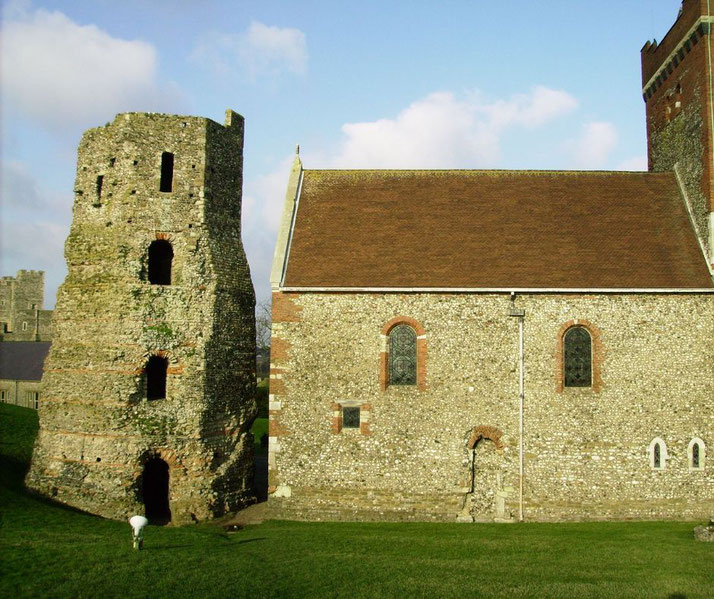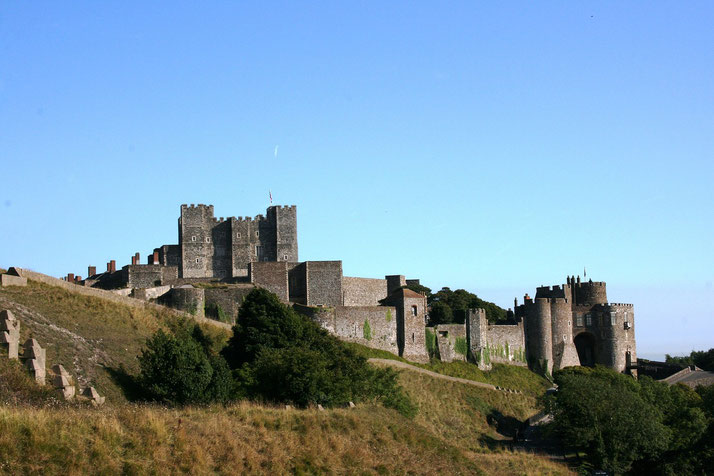The mighty Dover Castle: An impregnable fortress on the edge of England

Dover Castle, which rises above the white cliffs of Kent, has guarded the narrowest point of the English Channel for centuries.
Its important position made it the gateway to England and a key line of defence against invasion. The site saw continuous use from the Iron Age, with early Britons, who strengthened the hill, and with Romans, who built a lighthouse in the first century AD.
The Roman pharos, which still survives today, is one of the best-preserved Roman lighthouses in Britain and among the few remaining examples in Europe.
When William the Conqueror arrived in 1066, he quickly fortified the site to secure Norman control and protect the route between London and the Continent.
The Rebuilding under Henry II
During the reign of Henry II, major reconstruction efforts transformed Dover from a timber stronghold into one of Europe’s strongest castles.
Starting in the 1180s, his engineers created a concentric castle system that placed the great keep at its core.
The construction of the keep began around 1180 and was completed by 1189. The stone tower was designed by Maurice the Engineer and was built with thick walls, corner turrets, and a complex internal structure for both defence and comfort.
Maurice, a prominent royal architect, is also believed to have worked on early phases of the Tower of London, though his involvement at Newcastle Castle is less certain.
It included accommodation for the royal family and storage for food and supplies to endure long sieges.
The keep, which stood approximately 83 feet high and measured 100 feet square, was one of the most noteworthy royal castles of its time.
The works cost over £6,000, a remarkable expense in the twelfth century.

Around the keep, the builders constructed layers of curtain walls, towers, and fortified gatehouses, all designed to force attackers into narrow kill zones.
Engineers dug deep defensive ditches and created new outer wards to improve the layout.
Defensive architecture developed quickly in this period, and Dover’s design incorporated the new techniques known to medieval Europe.
The works cost vast sums of money and required skilled masons, carpenters, and labourers drawn from across the country.
Surviving Siege and Strengthening the Defences
In 1216, Dover Castle faced a direct military test when Prince Louis of France invaded during the First Barons’ War.
Rebel English barons opened the gates of many towns to the French, but Dover’s garrison, commanded by Hubert de Burgh, refused to surrender.
Louis laid siege to the castle and attempted to mine beneath the outer walls, but defenders launched a successful countermining effort.
They undermined the attackers’ tunnel, collapsed the structure, and forced the French to withdraw.
Contemporary accounts suggest that Louis arrived with a sizable force, with some estimates ranging up to 14,000 men, though modern historians believe the actual number was likely between 7,000 and 10,000.
After the siege, engineers repaired and reinforced the damage. Edward I later strengthened the outer curtain walls and added more towers, especially along the northern approach.
These included the Constable's Gate and Fitzwilliam Gate, which improved access control and defence.
The barbican was redesigned, and new gatehouses were equipped with portcullises, drawbridges, and arrow loops.
The castle became more than a military fortress; it acted as a symbol of royal authority and a secure stronghold for the storage of royal treasure and documents during periods of unrest.
The Treaty of Lambeth in 1217, which followed his military setbacks and a loss of baronial support, ultimately ended Louis’s ambitions for the English crown.
Adaptation during the Napoleonic Wars
By the late eighteenth century, the threat of French invasion returned under Napoleon Bonaparte.
British military engineers began adapting Dover Castle to meet modern warfare requirements.
Between 1797 and 1805, they cut extensive tunnels into the chalk cliffs beneath the castle to house garrisons, storage rooms, and gunpowder magazines.
These tunnels, which were initially dug as a single level during the Napoleonic period, were later expanded into a three-level complex during the Second World War.

Above ground, additional batteries and gun positions were added to face the Channel.
Barracks for officers and enlisted men were constructed within the tunnels, and the design allowed for year-round occupation.
Ventilation shafts and chimneys helped prevent smoke build-up and provided heat for cooking.
Units stationed here included the Royal Engineers and Royal Artillery, who maintained the fortress and ensured rapid response to coastal threats.
Dover became a centre for supply and organisation, able to house more than 2,000 soldiers ready to repel a landing force.
Wartime Command Centre in the Second World War
During the Second World War, Dover Castle again played a key role in national defence.
The tunnels from the Napoleonic period were repurposed as an underground command centre.
In 1940, Admiral Bertram Ramsay directed Operation Dynamo from beneath the castle walls.
Between 27 May and 4 June, nearly 340,000 Allied troops were evacuated from Dunkirk.
Dover’s location and its hidden communications centre made it an ideal headquarters for such a remarkable rescue.
The tunnels expanded into a self-contained command post, complete with telephone switchboards, planning rooms, and a hospital.
Designated areas such as the Casemate level and Annexe level were fitted for specific tasks.
As Luftwaffe raids pounded southern England, the castle’s position within the cliffs helped shield it from aerial attack.
Radar operators and coastal artillery units nearby received instructions from within the tunnel system.
Other key figures included Vice-Admiral Frederick Wake-Walker, who coordinated naval operations alongside Ramsay.
Throughout the war, Dover acted as a launch point for operations against occupied France and helped coordinate naval patrols across the Channel.
The area became known as "Hellfire Corner" due to the severity of German bombardments.
Preservation and National Importance
After 1945, the military no longer used the castle as an active garrison. However, its historical value ensured its continued care.
English Heritage acquired responsibility for the site in 1984 and undertook repair work of its various layers.
The medieval keep was furnished in a way that reflects the reign of Henry II; the tunnels were opened for tours; and the Roman lighthouse received protection as one of the oldest standing structures in England.
Today, Dover Castle attracts visitors who wish to walk the same paths as medieval knights, royal engineers, and wartime commanders.
It holds a rare position as a fortress that witnessed nearly every major chapter in England’s military history.
Its impressive dimensions confirmed its role as one of the country’s most important and carefully maintained historical sites and demonstrated that it could endure the test of time.
Visitor numbers now exceed 350,000 annually, and recent restorations supported by the Heritage Lottery Fund have helped ensure its continued preservation for future generations.
What do you need help with?
Download ready-to-use digital learning resources
Copyright © History Skills 2014-2025.
Contact via email
With the exception of links to external sites, some historical sources and extracts from specific publications, all content on this website is copyrighted by History Skills. This content may not be copied, republished or redistributed without written permission from the website creator. Please use the Contact page to obtain relevant permission.





